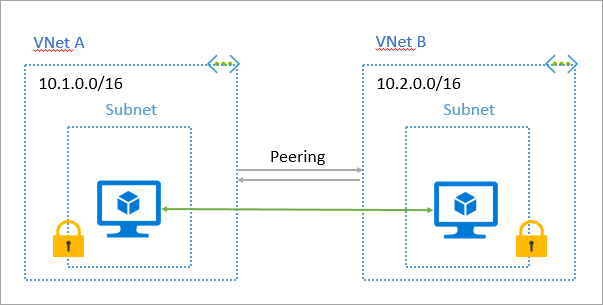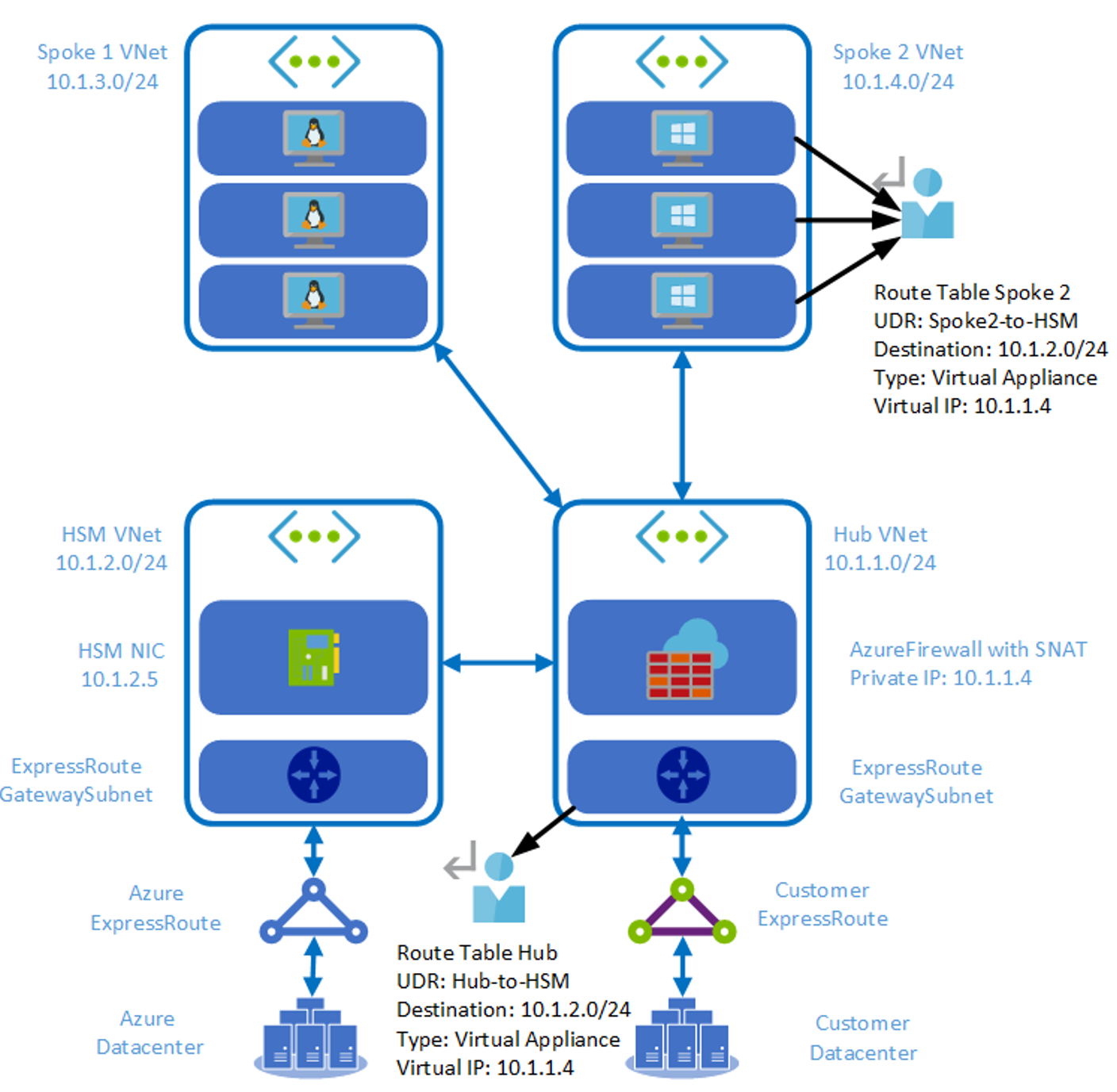Note
Access to this page requires authorization. You can try signing in or changing directories.
Access to this page requires authorization. You can try changing directories.
Azure Dedicated HSM demands a robust, secure networking infrastructure across all deployment scenarios. Whether connecting from the Azure cloud to your on-premises environment, implementing distributed applications, or establishing high availability configurations, comprehensive security is essential. Azure Networking delivers security through four critical networking areas that require careful planning and implementation.
- Creating HSM devices inside your virtual network (VNet) in Azure
- Connecting on-premises to cloud-based resources for the configuration and management of HSM devices
- Creating and connecting virtual networks for inter-connecting application resources and HSM devices
- Connecting virtual networks across regions for inter-communication and also to enable high availability scenarios
Virtual network for your Dedicated HSMs
Dedicated HSMs are integrated into a virtual network and placed in the customers' own private network in Azure. This enables access to the devices from virtual machines or compute resources in the virtual network.
For more information on integrating Azure services into the virtual network and the capabilities it provides, see Virtual network for Azure services documentation.
Virtual networks
Customers must create a virtual network in Azure before provisioning, or use one that already exists in the customers' subscription. The virtual network defines the security perimeter for the Dedicated HSM device. For more information on creating virtual networks, see virtual network documentation.
Subnets
Subnets segment the virtual network into separate address spaces usable by the Azure resources you place in them. Dedicated HSMs are deployed into a subnet in the virtual network. Each Dedicated HSM device that is deployed in the customer's subnet receives a private IP address from this subnet.
The subnet in which the HSM device is deployed must be explicitly delegated to the service: Microsoft.HardwareSecurityModules/dedicatedHSMs. This grants certain permissions to the HSM service for deployment into the subnet. Delegation to Dedicated HSMs imposes certain policy restrictions on the subnet. Network Security Groups (NSGs) and User-Defined Routes (UDRs) are currently not supported on delegated subnets. As a result, once a subnet is delegated to dedicated HSMs, it can only be used to deploy HSM resources. Deployment of any other customer resources into the subnet fail. There is no requirement on how large or small the subnet for Dedicated HSM should be, however each HSM device consumes one private IP, so it should be ensured the subnet is large enough to accommodate as many HSM devices as required for deployment.
ExpressRoute gateway
A requirement of the current architecture is configuration of an ExpressRoute gateway in the customers subnet where an HSM device needs to be placed to enable integration of the HSM device into Azure. The ExpressRoute gateway cannot be utilized for connecting on-premises locations to the customers HSM devices in Azure.
Connecting your on-premises IT to Azure
When you are creating cloud-based resources, establishing a private connection back to on-premises IT resources is a typical requirement. For Azure Dedicated HSM deployments, such connections primarily serve the HSM client software needs for device configuration, backup operations, and retrieving logs from HSMs for analysis.
When you are choosing connectivity options, the nature of your connection represents a key decision point. Site-to-Site VPN offers the most flexibility, especially when multiple on-premises resources need secure communication with Azure cloud resources, including HSMs. Implementing a Site-to-Site VPN requires organizations to deploy a VPN device to facilitate the connection. Alternatively, Point-to-Site VPN connections work well when only a single on-premises endpoint exists, such as an administration workstation.
For more information on connectivity options, see VPN Gateway planning options.
Note
ExpressRoute is not an option for connection to on-premises resources. It should also be noted that the ExpressRoute Gateway used in this context is not for connections to on-premises infrastructure.
Point-to-site VPN
A point-to-site Virtual Private Network is the simplest form of secure connection to a single endpoint on-premises. This may be relevant if you only have a single administration workstation for Azure-based dedicated HSMs.
Site-to-site VPN
A site-to-site Virtual Private Network enables secure communication between Azure-based Dedicated HSMs and your on-premises IT infrastructure. Organizations often implement such connections when maintaining an on-premises backup facility for HSMs, as the secure tunnel supports necessary data transfers for backup operations between both environments.
Connecting virtual networks
A typical deployment architecture for Dedicated HSM starts with a single virtual network and corresponding subnet in which the HSM devices are created and provisioned. Within that same region, there may be more virtual networks and subnets for application components that make use of the Dedicated HSM. To enable communication across these networks, we use Virtual Network Peering.
Virtual network peering
When there are multiple virtual networks within a region that need to access each other's resources, Virtual Network Peering creates secure communication channels between them. Virtual network peering provides not only secure communications but also ensures low-latency and high-bandwidth connections between the resources in Azure.

Connecting across Azure regions
The HSM devices have the ability, via software libraries, to redirect traffic to an alternate HSM. Traffic redirection is helpful if devices fail or access to a device is lost. Regional level failure scenarios can be mitigated by deploying HSMs in other regions and enabling communication between virtual networks across regions.
Cross region HA using VPN gateway
For globally distributed applications or for high availability regional failover scenarios, it is required to connect virtual networks across regions. With Azure Dedicated HSM, high-availability can be achieved by using a VPN Gateway that provides a secure tunnel between the two virtual networks. For more information on Vnet-to-Vnet connections using VPN Gateway, see the article titled What is VPN Gateway?
Note
Global Vnet peering is not available in cross-region connectivity scenarios with Dedicated HSMs at this time. VPN gateway should be used instead.

Networking restrictions
Note
A constraint of the Dedicated HSM service using subnet delegation is imposed restrictions that should be considered when designing the target network architecture for an HSM deployment. Use of subnet delegation means NSGs, UDRs, and Global VNet Peering are not supported for Dedicated HSM. The following sections provide help with alternative techniques to achieve the same or a similar outcome for these capabilities.
Network security limitations
The HSM network interface card (NIC) located within the Dedicated HSM VNet cannot utilize Network Security Groups (NSGs) or User Defined Routes (UDRs) due to subnet delegation requirements. This creates an important security consideration: you cannot implement default-deny policies directly from the Dedicated HSM VNet perspective. Instead, security must be implemented by explicitly allowing access from specific network segments to the Dedicated HSM service through alternative methods.
Adding the Network Virtual Appliances (NVA) Proxy solution also allows for an NVA firewall in the transit/DMZ hub to be logically placed in front of the HSM NIC, thus providing the needed alternative to NSGs and UDRs.
Solution architecture
This networking design requires the following elements:
- A transit or DMZ hub VNet with an NVA proxy tier. Ideally two or more NVAs are present.
- An ExpressRoute circuit with a private peering enabled and a connection to the transit hub VNet.
- A VNet peering between the transit hub VNet and the Dedicated HSM VNet.
- An NVA firewall or Azure Firewall can be deployed offer DMZ services in the hub as an option.
- Additional workload spoke VNets can be peered to the hub VNet. The Gemalto client can access the dedicated HSM service through the hub VNet.

Since adding the NVA proxy solution also allows for an NVA firewall in the transit/DMZ hub to be logically placed in front of the HSM NIC, thus providing the needed default-deny policies. In our example, we use the Azure Firewall for this purpose and need the following elements in place:
- An Azure Firewall deployed into subnet "AzureFirewallSubnet" in the DMZ hub VNet
- A Routing Table with a UDR that directs traffic headed to the Azure ILB private endpoint into the Azure Firewall. This Routing Table is applied to the GatewaySubnet where the customer ExpressRoute Virtual Gateway resides.
- Network security rules within the AzureFirewall to allow forwarding between a trusted source range and the Azure IBL private endpoint listening on TCP port 1792. This security logic adds the necessary "default deny" policy against the Dedicated HSM service. Meaning, only trusted source IP ranges are allowed into the Dedicated HSM service. All other ranges are dropped.
- A Routing Table with a UDR that directs traffic headed to on-premises into the Azure Firewall. This Routing Table is applied to the NVA proxy subnet.
- An NSG applied to the Proxy NVA subnet to trust only the subnet range of the Azure Firewall as a source, and to only allow forwarding to the HSM NIC IP address over TCP port 1792.
Note
Because the NVA proxy tier will SNAT the client IP address as it forwards to the HSM NIC, no UDRs are required between the HSM VNet and the DMZ hub VNet.
Alternative to UDRs
The NVA tier solution mentioned works as an alternative to UDRs. There are some important points to note.
- Network Address Translation should be configured on NVA to allow for return traffic to be routed correctly.
- Customers should disable the client ip-check in Luna HSM configuration to use VNA for NAT. The following commands serve as an example.
Disable:
[hsm01] lunash:>ntls ipcheck disable
NTLS client source IP validation disabled
Command Result : 0 (Success)
Show:
[hsm01] lunash:>ntls ipcheck show
NTLS client source IP validation : Disable
Command Result : 0 (Success)
- Deploy UDRs for ingress traffic into the NVA tier.
- As per design, HSM subnets will not initiate an outbound connection request to the platform tier.
Alternative to using global VNET peering
There are a couple of architectures you can use as an alternative to Global VNet peering.
- Use Vnet-to-Vnet VPN Gateway Connection
- Connect HSM VNET with another VNET with an ER circuit. This works best when a direct on-premises path is required or VPN VNET.
HSM with direct ExpressRoute connectivity
